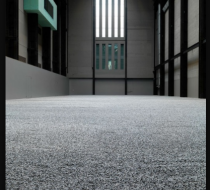Ai Weiwei: Sunflower Seeds 1 Favorite
Ai Weiwei’s Sunflower Seeds is made up of millions of small works, each apparently identical, but actually unique. However realistic they may seem, these life-sized sunflower seed husks are in fact intricately hand-crafted in porcelain.
Each seed has been individually sculpted and painted by specialists working in small-scale workshops in the Chinese city of Jingdezhen. Far from being industrially produced, they are the effort of hundreds of skilled hands. Poured into the interior of the Turbine Hall’s vast industrial space, the 100 million seeds form a seemingly infinite landscape.
Porcelain is almost synonymous with China and, to make this work, Ai Weiwei has manipulated traditional methods of crafting what has historically been one of China’s most prized exports. Sunflower Seeds invites us to look more closely at the ‘Made in China’ phenomenon and the geo-politics of cultural and economic exchange today.
The landscape of sunflower seeds can be looked upon from the Turbine Hall bridge, or viewed at close range in the east end of the Turbine Hall on Level 1. It is no longer possible to walk on the surface of the work, but visitors can walk close to the edges of the sunflower seed landscape on the west and north sides.
Although porcelain is very robust, we have been advised that the interaction of visitors with the sculpture can cause dust which could be damaging to health following repeated inhalation over a long period of time. In consequence, Tate, in consultation with the artist, has decided not to allow members of the public to walk across the sculpture.
Sunflower Seeds is a total work made up of millions of individual pieces which together from a single unique surface. In order to maintain and preserve the landscape as a whole, Tate asks visitors not to touch or remove the sunflower seeds.








